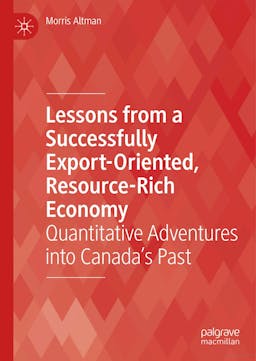
Book Review
Lessons from a Successfully Export-Oriented, Resource-Rich Economy: Quantitative Adventures into Canada’s Past, 2022
By Morris Altman
Canadian economic history is a strange field. Multiple works are produced. However, few economists are involved – something that is not the case for British, Latin American, American, French and Russian economic history (fields with which I am some familiarity). Indeed, these areas of economic history are marked by far greater degrees of collaboration and dialogues between economists and historians than for Canada. Why is that? One stark reason for this could be that the imperialism of economic methods (which I personally advocate) is often matched with a snobbery for historical methods (which I also advocate) and disdain for its practitioners. This invites a response on the part of historians that consists in (reasonably) ignoring those who are rude. The problem is that this often seems to be the assumption going against all economists. Morris Altman (and I hope myself too) should be exempted from this assumption.
Altman’s book is essentially a collection of works he has published over the years (since the early 1980s). Many of them were actually published in history journals such as William & Mary Quarterly, Agricultural History and Historical Reflections. Upon consulting the chapters that reproduce these articles, one sees a courteous and exhaustive engagement with a rich historical literature with the added difference that economic methods (i.e., price theory) are extensively used.
This work has been unfortunately ignored by historians. For example, consider his chapter on seigneurial tenure – the strange feudal transplant into Quebec from France during the colonial era which the British preserved until 1854. Historians have gradually diminished the importance of the institution on economic activity notably because everyone who argued that it had slowed development had been focusing on agricultural productivity. As there were few signs of farm productivity differences between seigneurial and non-seigneurial areas within Quebec (something that I empirically confirmed using causal inference methods in an article published in the Journal of Development Economics), the case appeared close. However, Altman’s rich reading of the historical material led him to propose an alternative explanation based on how income redistribution from peasant to landlord altered the structure of demand in a manner that deterred industrial development (and, in turn, growth). Many prominent works of Canadian history actually rely on similar arguments when income inequality is invoked. This begs the question of why is Altman’s work ignored? Whether one agrees with them is irrelevant – if the same theory is used for so many things in Canadian history, why is it ignored for this particular case? Would it be a byproduct of the reaction of historians to the usual arrogance of economists (which Altman does not display)? I believe it is and it is a damn shame!
There are other criminally neglected articles (which are included as chapters in the book). For example, there is a rich set of estimates of economic activity that can be used to compare economic growth and activity with the American colonies. Any enterprising historian could have extended his estimates to the early 1900s and, in the process, resolved a multiplicity of debates (e.g., the agricultural crisis, pre-confederation growth, regional divergence, the effects of the reciprocity treaty of 1854 and other trade agreements). This, unfortunately, was left to economists such as myself who have proceeded in replicating the efforts of Altman (in the same respectful manner towards historians, their sources and methods) and extending them to circa 1900.
Also criminally-neglected is a reproduction of a 1986 article in the Journal of Economic History offers a strong rebuttal of the argument that Quebec’s slow economic development was due to “bad geography”. This is a recurrent trope in Canadian economic history and it has served as an easy way out to explain regional income differences. Since 1986, there have been works by Alex Chernoff (in Acadiensis) showing that similar geographical arguments did not hold for Atlantic Canada circa 1870. Chernoff found that the provinces of the Atlantic did have bad farmland but their closer proximity to the sea gave them a strong edge in terms of manufacturing productivity. Similarly, in work with Louis Rouanet, I showed in an article in the Southern Economic Journal that bad farmland could not explain income differences between Ontario and Quebec circa 1842. Yet, both of these works are successors to Altman’s demonstration that geography’s role is overstated (if not trivial).
These are but three illustrations of high-quality works that Altman has published and which have been ignored. This book should provide some remedy to this problem by making these works more conveniently available.
To convince the reluctant historian who may still find it uninteresting to read what an economist has to say, I should point out in conclusion that Altman also challenges many conceptions that economists have. Altman produced a revision of GDP statistics that are generally unquestioned by economists – he showed several important flaws that affected trends in income growth. More precisely, he provided a strong challenge to the argument that the “wheat boom” of the 1890s was no big deal (as argued by Chambers and Gordon in the Journal of Political Economy – the top journal in economics -- in 1966). If Altman was willing to engage with the best version of all the different literature and that he did so with class, then there is no good reason to ignore him and his work.
Vincent Geloso
George Mason University